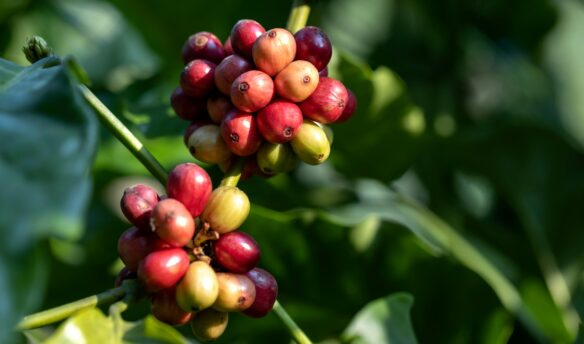Big US coffee chains bounce back from the pandemic, a new guide encourages equitable coffee buying, and Starbucks is again extending benefits—but only to non-unionized employees.
Let’s dive in.
‘$45.5bn US Branded Coffee Shop Market Approaches Full Covid-19 Recovery’ – via World Coffee Portal
A new report states that sales at branded coffee shops—think big chains and recognizable names—have nearly bounced back to pre-pandemic levels. The report, called Project Café USA 2023 and published by Allegra World Coffee Portal, shows that sales at branded shops rose 10% over the last year.
The 10% rise puts branded shops at about 96% of what they were bringing in pre-pandemic. To put that into context, branded coffee shops made $45.8 billion over the 12 months ending in June 2022. Half of all chains reporting sales data said they saw 5% or more increases.
Project Café 2023 also notes that the number of open shops has surpassed pre-pandemic levels, increasing 2.8% to over 38,000 stores. Starbucks, Dunkin’, and Panera Bread—the country’s largest chains—all increased their US presence.
In terms of branded shops, Starbucks continues to dominate, opening hundreds of new stores over the last twelve months. The report says the brand opened “net 302 stores,” a reminder that Starbucks has also closed dozens of locations over the last year—the company citing crime and public safety, and Starbucks Workers United alleging anti-union motivation.
Starbucks’ continued growth means they now represent 41% of all branded shops in the US, with a heavy focus on drive-thru options to reflect changing consumer habits. “Preferences that gained popularity during the pandemic, such as pre-ordering, delivery and drive-thru, are set to remain as consumers maintain a heightened desire for convenience,” the report says.
Staff shortages “remain a major challenge for US operators following the easing of Covid-19 restrictions,” the report says. It continues on, claiming that many coffee workers have “reconsidered their careers during the pandemic.” However, it’s also worth noting that many working-age people died from COVID-19, and millions are still out of work due to Long Covid symptoms.
The report remains bullish about the prospect for more growth, anticipating that sales will exceed $55.9 billion in 2027 “as US consumer demand for premium out-of-home coffee products continues unabated.”
‘The Sustainable Coffee Buyers Guide is Using Data to Increase Consciousness’ – via Daily Coffee News
On the other end of the coffee supply chain, the Sustainable Coffee Buyers Guide is a new data-driven tool designed to encourage equitable green buying practices.
The guide is essentially an impact calculator: it focuses on farmgate prices, or the actual price a farmer is paid. The calculator then breaks down the effect a given price would have on a coffee producer. “We want to make people specifically conscious of what the farmer received for the coffee,” guide co-creator Vera Espíndola Rafael said. Along with Rafael, the guide was built in collaboration with Colombia-based Azahar Coffee Company and coffee software company Cropster.
The calculator shows how each price measures up against four different metrics: poverty price, legal price, living price, and prosperous price. Each tier is determined mathematically—for example, the prosperous price “is set by using a 50/30/20 rule: 50% is to cover cost of production; 30% is to cover cost of living; and 20% is for additional savings.” The metrics are further differentiated by region, reflecting the cost of living in the various areas throughout Colombia (currently, the tool only shows pricing breakdowns in Colombia with plans to expand beyond).
The second function of the guide will launch in November and include a paid subscription option to give buyers tools for determining how much they should be paying for coffee “based on the income needs and goals of producers.” The subscription revenue will be used to ensure that the data collected will not adversely affect farmers, partially by giving farmers free access to all information. “They are the data owners,” Rafael said, “so they deserve this information back.”
More News
‘Pumpkin Spice Is Now Dictionary Official’ – via Sprudge
‘Local Coffee Farmers Brace for Yields up to 40% Lower Than Usual’ – via Hawaii Public Radio
‘Colombia’s Coffee Plantations Struggle With an Aging Workforce’ – via Pulitzer Center
‘Help Umeshiso Grow By Supporting Their GoFundMe’ – via Sprudge
‘Yemen’s Coffee Farmers Bid to Win Over Baristas to their Heritage Beans’ – via the Guardian
The Week in Coffee Unionizing
- Starbucks announced new financial benefits for employees this week—for non-unionized employees. New benefits include a personal savings account and a student loan management program. The move continues the company’s tactic of offering benefits, then claiming they cannot, by law, provide the same benefits to unionized workers without bargaining store-by-store. Starbucks Workers United has previously stated it would waive bargaining rights in order to implement a previously-announced benefits expansion.
- Jaz Brisack, a Starbucks barista in Buffalo and high-profile union worker, accused the company of forcing her out in retaliation for organizing. The union filed an unfair labor practice charge alleging discrimination in scheduling policies that effectively forced Brisack to resign, a charge that Starbucks denies.
- Hundreds of workers with Starbucks Workers United protested in front of the company’s Seattle headquarters during a biennial investors’ day. The event brings together executives and investors to examine the company’s future—and has never once included frontline baristas, union reps say. The union wants a say in strategy and decision-making and asks the company to finally bargain with the 230+ stores that have so far voted to unionize.
Is Coffee Good For You?
Did you know you can crave coffee? You probably did if you’re reading this in the morning, but apparently, scientists didn’t—it’s only just being researched now.
A study published in the journal Eating Behaviours looked at the link between craving and consuming various non-alcoholic drinks such as coffee, water, and soda. As it turns out, you can crave all those things, and the triggers are almost exactly what you would guess.
Look, it’s a slow health news week, okay? Just go with it.
The main trigger for coffee cravings? Tiredness. For water? Thirst, obviously. It was a bit more abstract for soft drinks: “For soft drinks, visual clues such as advertising or seeing other people having a drink were the most common triggers, followed by food and then thirst,” said author Joshua McGreen of Flinders University.
The participants, all 128 of them, kept a “craving diary and daily consumption measure” for a week. According to the study, the number of cravings they recorded for a particular beverage would then predict how much they consumed, at least for coffee and soda. For water, the predictors were “how much participants liked water and whether they were male.” This is a weird finding, but this whole study is a little weird.
So there you have it: being tired might trigger a craving for coffee, and seeing a billboard might make you want a Sprite. Science!
Beyond the Headlines
‘Embracing Neurodiversity In The Modern Cafe’ by Jenn Chen’
‘Column: Specialty Coffee Stands Upon an Unsustainable Foundation of Double Standards’ by Nanelle Newbom
‘Falling Leaves, Fall Flavors: Signature Beverages for the Autumn 2022 Season’ by RJ Joseph
















